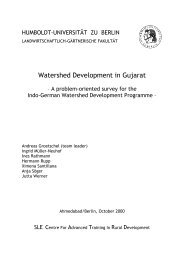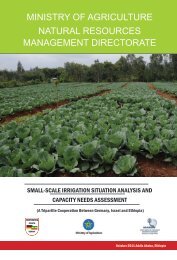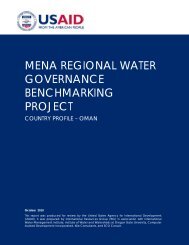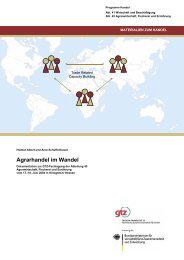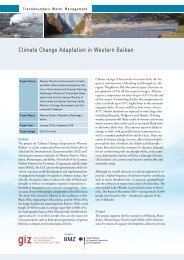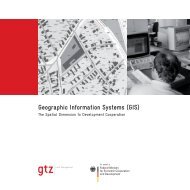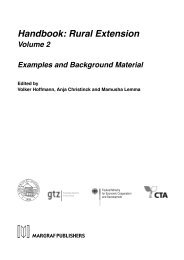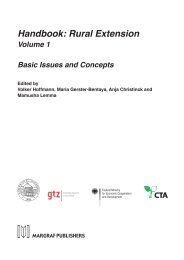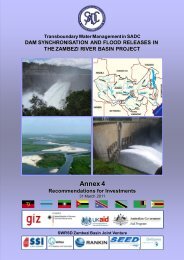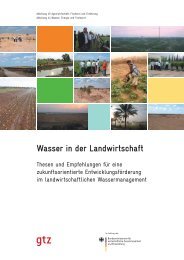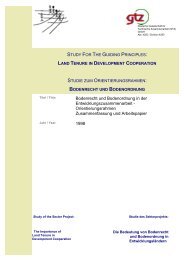Farming in the - WordPress.com
Farming in the - WordPress.com
Farming in the - WordPress.com
You also want an ePaper? Increase the reach of your titles
YUMPU automatically turns print PDFs into web optimized ePapers that Google loves.
14<br />
Analysis of <strong>the</strong> agricultural situation <strong>in</strong> Azraq Bas<strong>in</strong><br />
German-Jordanian Programme “Management of Water Resources”<br />
III – Awareness about water<br />
overexploitation: progressive<br />
sett<strong>in</strong>g of a regulated water<br />
management framework<br />
3.1. Competition over<br />
limited water resource: a<br />
threat to <strong>the</strong> susta<strong>in</strong>ability<br />
of Azraq Bas<strong>in</strong> (context and<br />
general consequences of<br />
overexploitation of water)<br />
The absence of a specific policy that<br />
mitigates agricultural expansion<br />
and land exploitation has led to a<br />
dangerous spread of agricultural<br />
<strong>in</strong>vestments and a sharp <strong>in</strong>crease<br />
<strong>in</strong> groundwater exploitation over<br />
<strong>the</strong> past three decades. In addition,<br />
water was pumped for urban<br />
consumption. In 1963 and 1970, small<br />
quantities of Azraq’s groundwater<br />
were pumped to Irbid. In 1980,<br />
water used for agriculture was<br />
conf<strong>in</strong>ed only to <strong>the</strong> spr<strong>in</strong>gs which<br />
flowed naturally near <strong>the</strong> surface 23 .<br />
At that time, <strong>the</strong> wetland of Azraq<br />
oasis was covered with water on a<br />
total area 6 km 2 . In 1981, Amman<br />
Water Sewerage Authority (AWSA)<br />
began pump<strong>in</strong>g water to Amman<br />
at a rate of 1.5 MCM/y. In 1982,<br />
AWSA drilled 15 wells <strong>in</strong> nor<strong>the</strong>rn<br />
parts of <strong>the</strong> Azraq Oasis <strong>in</strong> order<br />
to meet <strong>the</strong> domestic water needs<br />
of Amman and Zarqa (average well<br />
abstraction 17 MCM/y). Today, <strong>the</strong><br />
total number of agricultural wells<br />
is 865, with 481 work<strong>in</strong>g artesian<br />
wells and a few manual wells 24 ,<br />
ma<strong>in</strong>ly <strong>in</strong> Ratami. Azraq Bas<strong>in</strong><br />
currently provides 25% of Amman’s<br />
potable water. The total abstraction<br />
from <strong>the</strong> bas<strong>in</strong> almost tripled <strong>in</strong> 20<br />
years: it <strong>in</strong>creased from 21.6 MCM/y<br />
<strong>in</strong> 1983 to 58.5 MCM/y <strong>in</strong> 2004. This<br />
over-exploitation led to a drop <strong>in</strong><br />
<strong>the</strong> water table by 0.3 to 0.8 meter<br />
per year, (some wells are reported<br />
to have dropped by 20 meters),<br />
<strong>in</strong>creas<strong>in</strong>g water quality problems<br />
due to dramatic sal<strong>in</strong>ation of <strong>the</strong><br />
aquifer or pollution, and to <strong>the</strong><br />
dry<strong>in</strong>g up of <strong>the</strong> wetlands 25 .<br />
Today, <strong>the</strong> problem of groundwater<br />
overdraft rema<strong>in</strong>s with over<br />
abstraction reach<strong>in</strong>g 215% of <strong>the</strong><br />
safe limit (def<strong>in</strong>ition):<br />
- Safe yield be<strong>in</strong>g 24 MCM/y.<br />
- Abstraction reach<strong>in</strong>g 51.16 MCM/<br />
y 27 <strong>in</strong> 2009 26 (27.5 for agriculture,<br />
22.9 for governmental dr<strong>in</strong>k<strong>in</strong>g<br />
water wells for dr<strong>in</strong>k<strong>in</strong>g water<br />
and 0.76 for o<strong>the</strong>r purposes).<br />
Illegal abstraction from <strong>the</strong> Azraq<br />
bas<strong>in</strong>, which is <strong>the</strong> abstraction<br />
from wells that are registered<br />
as “illegal wells”, amounts to<br />
13 MCM/y. The situation <strong>in</strong> North<br />
Badia is <strong>com</strong>pletely different as<br />
90% of <strong>the</strong> farms have <strong>the</strong>ir wells<br />
registered 28 .<br />
23 Wael Sartawi, MoA, 1980.<br />
24 WAJ Azraq, 2009.<br />
25 Van Aken, 2007. Historical trajectory of a river Bas<strong>in</strong> <strong>in</strong> <strong>the</strong> Middle East – <strong>the</strong> Lower Jordan River Bas<strong>in</strong> (<strong>in</strong> Jordan).<br />
26 Data WAJ 2009.<br />
27 WAJ Azraq estimations, 2009.<br />
28 Source: Highlands Farm Survey, 2008, Internal Report, Water Focal Po<strong>in</strong>t.



